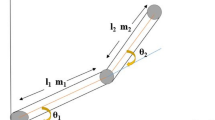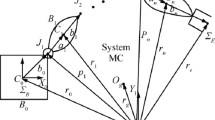Abstract
Flexible manipulators are widely used in aerospace industry and precision instrument manufacturing industry. However, due to the mechanism flexibility, the system dynamics have high nonlinearity and complexity, which make controller design pretty challenging. Moreover, in real production, electromechanical systems, including flexible manipulators, usually suffer from nonlinear input dead-zones and unknown system parameters/structures. Considering the above problems, an adaptive fuzzy control method is proposed, which can make the flexible link reach a desired rotation angle within finite time and simultaneously suppress the vibration of the manipulator. In the meantime, the system uncertainties are compensated, and the effect of input dead-zones is eliminated. In addition, the stability of the equilibrium point for the single-link flexible manipulator system is proven by rigorous theoretical analysis. Finally, the effectiveness and robustness of the proposed control method are verified by numerical simulations.
















Similar content being viewed by others
References
Sun, W., Su, S., Xia, J., Wu, Y.: Adaptive tracking control of wheeled inverted pendulums with periodic disturbances. IEEE Trans. Cybern. (2018). https://doi.org/10.1109/TCYB.2018.2884707
Sun, W., Lin, J., Su, S., Wang, N., Er, M.: Reduced adaptive fuzzy decoupling control for lower limb exoskeleton. IEEE Trans. Cybern. (2020). https://doi.org/10.1109/TCYB.2020.2972582
Xiao, B., Yin, S., Kaynak, O.: Tracking control of robotic manipulators with uncertain kinematics and dynamics. IEEE Trans. Ind. Electron. 63(10), 6439–6449 (2016)
Yang, C., Jiang, Y., Na, J., Li, Z., Cheng, L., Su, C.: Finite-time convergence adaptive fuzzy control for dual-arm robot with unknown kinematics and dynamics. IEEE Trans. Fuzzy Syst. 27(3), 574–588 (2019)
Zhou, Q., Zhao, S., Li, H., Lu, R., Wu, C.: Adaptive neural network tracking control for robotic manipulators with dead zone. IEEE Trans. Neural Netw. Learn. Syst. 30(12), 3611–3620 (2019)
Sun, Y., Xu, J., Qiang, H., Lin, G.: Adaptive neural-fuzzy robust position control scheme for maglev train systems with experimental verification. IEEE Trans. Ind. Electron. 66(11), 8589–8599 (2019)
Hou, S., Fei, J., Chen, C., Chu, Y.: Finite-time adaptive fuzzy-neural-network control of active power filter. IEEE Trans. Power Electron. 34(10), 10298–10313 (2019)
Tong, S., Min, X., Li, Y.: Observer-based adaptive fuzzy tracking control for strict-feedback nonlinear systems with unknown control gain functions. IEEE Trans. Cybern. (2020). https://doi.org/10.1109/TCYB.2020.2977175
Qian, D., Ding, H., Lee, S., Bae, H.: Suppression of chaotic behaviors in a complex biological system by disturbance observer-based derivative-integral terminal sliding mode. IEEE/CAA J. Autom. Sinica 7(1), 126–135 (2020)
Huang, L., Li, Y., Tong, S.: Fuzzy adaptive output feedback control for MIMO switched nontriangular structure nonlinear systems with unknown control directions. IEEE Trans. Syst. Man Cybern. Syst 50(2), 550–564 (2020)
Li, Y., Yang, T., Tong, S.: Adaptive neural networks finite-time optimal control for a class of nonlinear systems. IEEE Trans. Neural Netw. Learn. Syst. (2019). https://doi.org/10.1109/TNNLS.2019.2955438
Xu, B., Shou, Y., Luo, J., Pu, H., Shi, Z.: Neural learning control of strict-feedback systems using disturbance observer. IEEE Trans. Neural Netw. Learn. Syst. 30(5), 1296–1307 (2019)
Sun, W., Su, S., Wu, Y., Xia, J., Nguyen, V.: Adaptive fuzzy control with high-order barrier Lyapunov functions for high-order uncertain nonlinear systems with full-state constraints. IEEE Trans. Cybern. (2019). https://doi.org/10.1109/TCYB.2018.2890256
Wang, A., Liu, L., Qiu, J., Feng, G.: Finite-time adaptive fuzzy control for nonstrict-feedback nonlinear systems via an event-triggered strategy. IEEE Trans. Fuzzy Syst. (2019). https://doi.org/10.1109/TFUZZ.2019.2931228
Wang, H., Liu, P.X., Zhao, X., Liu, X.: Adaptive fuzzy finite-time control of nonlinear systems with actuator faults. IEEE Trans. Cybern. 50(5), 1786–1797 (2020)
Chen, H., Sun, N.: Nonlinear control of underactuated systems subject to both actuated and unactuated state constraints with experimental verification. IEEE Trans. Ind. Electron. (2019). https://doi.org/10.1109/TIE.2019.2946541
He, W., Ge, S.S.: Cooperative control of a nonuniform gantry crane with constrained tension. Automatica 66, 146–154 (2016)
Zhang, M., Zhang, Y., Ouyang, H., Ma, C., Cheng, X.: Adaptive integral sliding mode control with payload sway reduction for 4-DOF tower crane systems. Nonlinear Dyn. (2020). https://doi.org/10.1007/s11071-020-05471-3
Ouyang, H., Xu, X., Zhang, G.: Tracking and load sway reduction for double-pendulum rotary cranes using adaptive nonlinear control approach. Int. J. Robust Nonlinear Control 30(5), 1872–1885 (2020)
Sun, N., Fu, Y., Yang, T., Zhang, J., Fang, Y., Xin, X.: Nonlinear motion control of complicated dual rotary crane systems without velocity feedback: Design, analysis, and hardware experiments. IEEE Trans. Autom. Sci. Eng. (2019). https://doi.org/10.1109/TASE.2019.2961258
Hung, L.C., Lin, H.P., Chung, H.Y.: Design of self-tuning fuzzy sliding mode control for TORA system. Expert Syst. Appl. 32(1), 201–212 (2007)
Cui, R., Ge, S.S., How, B.V.E., Choo, Y.S.: Leader-follower formation control of underactuated autonomous underwater vehicles. Ocean Eng. 37(17–18), 1491–1502 (2010)
Wang, N., Su, S.: Finite-time unknown observer-based interactive trajectory tracking control of asymmetric underactuated surface vehicles. IEEE Trans. Control Syst. Technol. (2019). https://doi.org/10.1109/TCST.2019.2955657
Pashkevich, A., Chablat, D., Wenger, P.: Stiffness analysis of overconstrained parallel manipulators. Mech. Mach. Theory 44(5), 966–982 (2009)
Giri, N., Walker, I.D.: Three module lumped element model of a continuum arm section. In: Proceedings of the 2011 IEEE/RSJ International Conference on Intelligent Robots and Systems, pp. 4060–4065. (2011)
Piras, G., Cleghorn, W.L., Mills, J.K.: Dynamic finite-element analysis of a planar high-speed, high-precision parallel manipulator with flexible links. Mech. Mach. Theory 40(7), 849–862 (2005)
Mohamed, Z., Chee, A., Hashim, A., Tokhi, M., Amin, S., Mamat, R.: Techniques for vibration control of a flexible robot manipulator. Robotica 24(4), 499–511 (2006)
Siciliano, B., Book, W.J.: A singular perturbation approach to control of lightweight flexible manipulators. Int. J. Robot. Res. 7(4), 79–90 (1988)
Abe, A.: Trajectory planning for flexible cartesian robot manipulator by using artificial neural network: Numerical simulation and experimental verification. Robotica 29(5), 797–804 (2011)
Deng, H., Sun, J.D., Huang, S.D., Cao, G.Z.: Vibration suppression of the flexible manipulator using optimal input shaper and linear quadratic regulator. In: Proceedings of the 12th International Conference on Ubiquitous Robots and Ambient Intelligence (URAI), pp. 255–260. (2015)
Zain, M.Z.M., Tokhi, M.O., Mohamed, Z.: Hybrid learning control schemes with input shaping of a flexible manipulator system. Mechatronics 16(3–4), 209–219 (2006)
Shan, J., Liu, H.T., Sun, D.: Modified input shaping for a rotating single-link flexible manipulator. J. Sound Vibr. 285(1–2), 187–207 (2005)
Lou, J., Liao, J., Wei, Y., Yang, Y., Li, G.: Experimental identification and vibration control of a piezoelectric flexible manipulator using optimal multi-poles placement control. Appl. Sci 7(3), 309 (2017)
Dogan, M., Istefanopulos, Y.: Optimal nonlinear controller design for flexible robot manipulators with adaptive internal model. IET Contr. Theory Appl. 1(3), 770–778 (2007)
Korayem, M.H., Nikoobin, A.: Maximum payload for flexible joint manipulators in point-to-point task using optimal control approach. Int. J. Adv. Manuf. Technol. 38(9–10), 1045–1060 (2008)
Jiang, T., Liu, J., He, W.: Boundary control for a flexible manipulator based on infinite dimensional disturbance observer. J. Sound Vibr. 348, 1–14 (2015)
Zhang, Y., Liu, J., He, W.: Vibration control for a nonlinear three-dimensional flexible manipulator trajectory tracking. Int. J. Control 89(8), 1641–1663 (2016)
Cao, F., Liu, J.: An adaptive iterative learning algorithm for boundary control of a coupled ODE-PDE two-link rigid-flexible manipulator. J. Franklin Inst. 354(1), 277–297 (2017)
Cao, F., Liu, J.: Vibration control for a rigid-flexible manipulator with full state constraints via Barrier Lyapunov Function. J. Sound Vibr. 406, 237–252 (2017)
Zhao, Z., Ahn, C.K.: Boundary antisaturation vibration control design for a flexible timoshenko robotic manipulator. Int. J. Robust Nonlinear Control 30(3), 1098–1114 (2020)
Song, B.J., Koivo, A.J.: Nonlinear predictive control with application to manipulator with flexible forearm. IEEE Trans. Ind. Electron. 46(5), 923–932 (1999)
Hassan, M., Dubay, R., Li, C., Wang, R.: Active vibration control of a flexible one-link manipulator using a multivariable predictive controller. Mechatronics 17(6), 311–323 (2007)
Dubay, R., Hassan, M., Li, C., Charest, M.: Finite element based model predictive control for active vibration suppression of a one-link flexible manipulator. ISA Trans. 53(5), 1609–1619 (2014)
Pradhan, S.K., Subudhi, B.: Nonlinear adaptive model predictive controller for a flexible manipulator: An experimental study. IEEE Trans. Control Syst. Technol. 22(5), 1754–1768 (2014)
Pedro, J.O., Tshabalala, T.: Hybrid NNMPC/PID control of a two-link flexible manipulator with actuator dynamics. In: Proceedings of the 10th Asian Control Conference (ASCC), pp. 1–6. (2015)
Zhang, S., Zhang, Y., Zhang, X., Dong, G.: Fuzzy PID control of a two-link flexible manipulator. J. Vibroeng. 18(1), 250–266 (2016)
Tian, L., Collins, C.: Adaptive neuro-fuzzy control of a flexible manipulator. Mechatronics 15(10), 1305–1320 (2005)
Chang, W., Tong, S., Li, Y.: Adaptive fuzzy backstepping output constraint control of flexible manipulator with actuator saturation. Neural Comput. Appl. 28(1), 1165–1175 (2017)
Zhang, J., Ma, G., Li, Z.: Boundary robust adaptive control of a flexible timoshenko manipulator. Complexity 2018, 7928495 (2018)
Li, H., Zhao, S., He, W., Lu, R.: Adaptive finite-time tracking control of full state constrained nonlinear systems with dead-zone. Automatica 100, 99–107 (2019)
Tang, Y., Sun, F., Sun, Z.: Neural network control of flexible-link manipulators using sliding mode. Neurocomputing 70(1–3), 288–295 (2006)
Abdollahi, F., Talebi, H.A., Patel, R.V.: A stable neural network-based observer with application to flexible-joint manipulators. IEEE Trans. Neural Netw. 17(1), 118–129 (2006)
Sun, C., Gao, H., He, W., Yu, Y.: Fuzzy neural network control of a flexible robotic manipulator using assumed mode method. IEEE Trans. Neural Netw. Learn. Syst. 29(11), 5214–5227 (2018)
Qiu, Z.C., Li, C., Zhang, X.M.: Experimental study on active vibration control for a kind of two-link flexible manipulator. Mech. Syst. Signal Proc. 118, 623–644 (2019)
Cheng, W.: Neural-fuzzy control of a flexible dynamic tracking and adjusting manipulator. Trans. Inst. Meas. Control 37(7), 883–891 (2015)
Sun, W., Su, S., Xia, J., Nguyen, V.: Adaptive fuzzy tracking control of flexible-joint robots with full-state constraints. IEEE Trans. Syst. Man Cybern. Syst 49(11), 2201–2209 (2019)
Kherraz, K., Hamerlain, M., Achour, N.: Robust neuro-fuzzy sliding mode controller for a flexible robot manipulator. Int. J. Robot. Autom. 30(1), 40–49 (2015)
Xu, B., Zhang, P.: Composite learning sliding mode control of flexible-link manipulator. Complexity 2017, 9430259 (2017)
Lochan, K., Singh, J.P., Roy, B.K., Subudhi, B.: Adaptive time-varying super-twisting global SMC for projective synchronisation of flexible manipulator. Nonlinear Dyn. 93(4), 2071–2088 (2018)
Zhang, Q., Mills, J.K., Cleghorn, W.L., Jin, J., Sun, Z.: Dynamic model and input shaping control of a flexible link parallel manipulator considering the exact boundary conditions. Robotica 33(6), 1201–1230 (2015)
Abe, A., Hashimoto, K.: A novel feedforward control technique for a flexible dual manipulator. Robot. Comput.-Integr. Manuf. 35, 169–177 (2015)
Yang, H., Liu, J., Lan, X.: Observer design for a flexible-link manipulator with PDE model. J. Sound Vibr. 341, 237–245 (2015)
Ge, S.S., Lee, T.H., Zhu, G.: A new lumping method of a flexible manipulator. In: Proceedings of the 1997 American Control Conference, pp. 1412–1416. (1997)
Li, Y., Li, K., Tong, S.: Finite-time adaptive fuzzy output feedback dynamic surface control for MIMO nonstrict feedback systems. IEEE Trans. Fuzzy Syst. 27(1), 96–110 (2019)
Sun, N., Fang, Y., Chen, H., Fu, Y., Lu, B.: Nonlinear stabilizing control for ship-mounted cranes with ship roll and heave movements: Design, analysis, and experiments. IEEE Trans. Syst. Man Cybern. Syst 48(10), 1781–1793 (2018)
Acknowledgements
The authors would like to sincerely thank the Associate Editor and all reviewers for the professional suggestions and comments, which are helpful to improve this paper’s quality. This work is supported by the National Key R&D Program of China under Grant 2018YFB1309000, the Joint Fund of Science & Technology Department of Liaoning Province and State Key Laboratory of Robotics, China under Grant 2020-KF-22-05, and the National Natural Science Foundation of China under Grant 61873134 and Grant U1706228.
Author information
Authors and Affiliations
Corresponding author
Rights and permissions
About this article
Cite this article
Zhang, C., Yang, T., Sun, N. et al. An Adaptive Fuzzy Control Method of Single-Link Flexible Manipulators with Input Dead-Zones. Int. J. Fuzzy Syst. 22, 2521–2533 (2020). https://doi.org/10.1007/s40815-020-00962-2
Received:
Revised:
Accepted:
Published:
Issue Date:
DOI: https://doi.org/10.1007/s40815-020-00962-2




